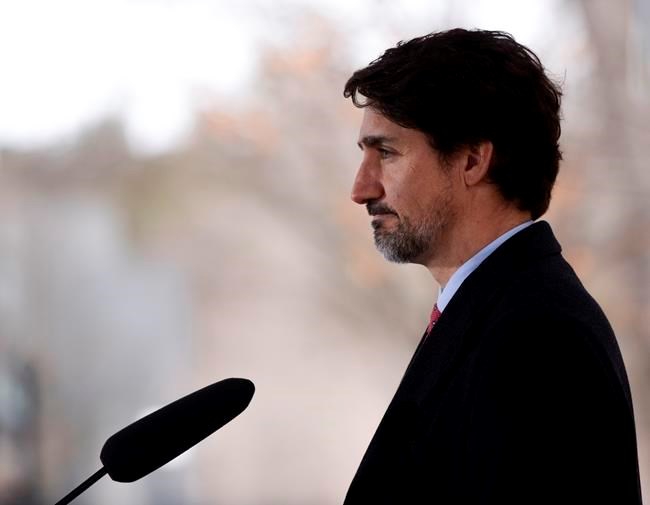WASHINGTON — The federal Liberal government used some of the sternest language diplomacy allows Thursday as it condemned a White House proposal to send soldiers to the Canada-U.S. border, ostensibly to keep illegal migrants from spreading COVID-19.
Canada has argued "forcefully" against the idea, said Deputy Prime Minister Chrystia Freeland, who was reluctant to characterize the status of the proposal — first reported by Global News — beyond saying a U.S. decision "has not yet been acted upon or fully taken."
But Freeland, who is normally pointed in refusing to conduct private negotiations in public, made clear that the idea is not finding favour in Ottawa.
"Canada is strongly opposed to this U.S. proposal and we have made that opposition very, very clear to our American counterparts," she told a media briefing in the national capital.
Indeed, it may never come to pass, she suggested: countries around the world, including Canada, have been responding with uncharacteristic speed and urgency to an escalating global emergency — a process that involves discussing any and all measures, no matter how drastic, even if they don't come to fruition.
"We understand the concerns about the coronavirus, we share those concerns very much," Freeland said.
"What we have said is, 'We really do not believe at all that there would be a public-health justification for you to take this action, of course it's up to you to decide for yourselves.' And we've said we really don't think this is the right way to treat a trusted friend and military ally."
Asked about the proposal Thursday, President Donald Trump didn't seem to know much about it. But he claimed, inexplicably, that the U.S. already has soldiers at the northern border, then veered off on a tangent about "illegal trade" coming in from Canada that sounded like a throwback to the "Tariff Man" days of 2018.
"We have very strong deployments on the southern border, and we had some troops in Canada, but I'll find out about that — I guess it's equal justice to a certain extent," Trump said, without explanation.
"In Canada, we do have troops along the border. We have a lot of things coming in from Canada — we have trade, some illegal trade that we don't like. We have very strong sanctions on some, we have very strong tariffs on dumping steel.
"We don't like steel coming through our border that's been dumped in Canada so they can avoid the tariffs."
Canada reached a deal with the U.S. in 2019 that lifted Trump's punishing tariffs on steel and aluminum imports, an agreement that included a Canadian commitment to take steps to prevent foreign steel and aluminum from being dumped in Canada and sold stateside.
The two countries already have a mutual ban in place on non-essential travel, but the movement of trade, commerce and cross-border workers has been allowed to continue — a clear indication that both Ottawa and the White House have embraced the economic importance of avoiding a complete shutdown at the border.
"Canada and the U.S. have the longest unmilitarized border in the world, and it is very much in both of our interests for it to remain that way," Prime Minister Justin Trudeau said during his own daily appearance outside Rideau Cottage in Ottawa.
It is no secret, however, that President Donald Trump has long been seized with securing his country's southern border with Mexico, and has recently been talking about fortifying those efforts under the pretence of protecting Americans from the novel coronavirus.
"We will continue to consider additional actions to ensure federal law enforcement personnel at our borders have the resources and operational support needed to address the profound public health threat of uncontrolled cross-border movement during a pandemic," the Trump administration said in a statement attributed to a senior official.
"Protecting our border is a national security priority and without proper precautions, which can only happen through orderly, lawful entry at the borders, the virus could pose greater risk to migrants, travelers, law enforcement personnel, health care professionals, and all Americans."
Trump has also made it clear that in an election year, he is chafing for a return to some form of economic normalcy, and sooner rather than later — the April 12 Easter weekend is his hoped-for timeline, a date that has left public-health officials incredulous.
"There is still a long battle ahead, but our efforts are already paying dividends," Trump wrote in a letter to governors the White House released Thursday that spells out plans to expand surveillance testing in order to classify the risk of infection on a county-by-county basis.
The idea, the letter said, is to give state and local officials the information they need to decide whether to maintain, increase or relax their protective efforts.
"As we enhance protections against the virus, Americans across the country are hoping the day will soon arrive when they can resume their normal economic, social and religious lives."
On Monday, the U.S. announced a 30-day agreement with both Canada and Mexico that includes immediately returning any illegal migrants to the country from which they arrived, or to their countries of origin if that isn't possible, rather than holding them at facilities in the U.S.
As part of the trilateral agreement announced earlier this week, Canada has agreed to turn away so-called "irregular" migrants who cross the border somewhere other than at an official port of entry.
When it comes to which of America's land borders pose the greatest security threat, it's no contest.
Over the course of fiscal 2017, the most recent year for which data is available, the U.S. Border Patrol apprehended nearly 304,000 illegal migrants along its southwestern border in Texas, Arizona and California, according to the Department of Homeland Security.
Over that same period, there were only 3,000 apprehensions along the Canada-U.S. border — just one per cent of the total.
This report by The Canadian Press was first published March 26, 2020.
James McCarten , The Canadian Press


